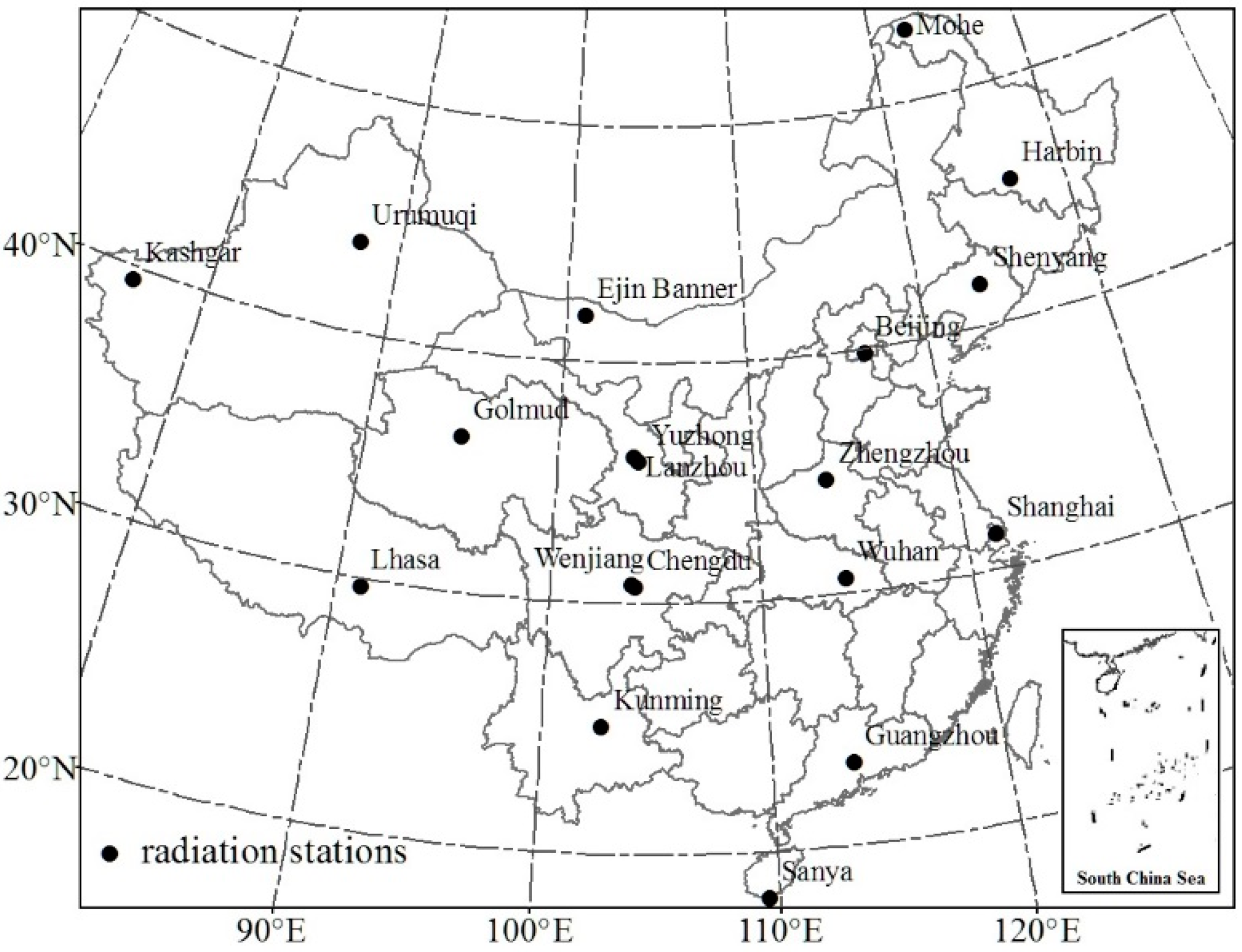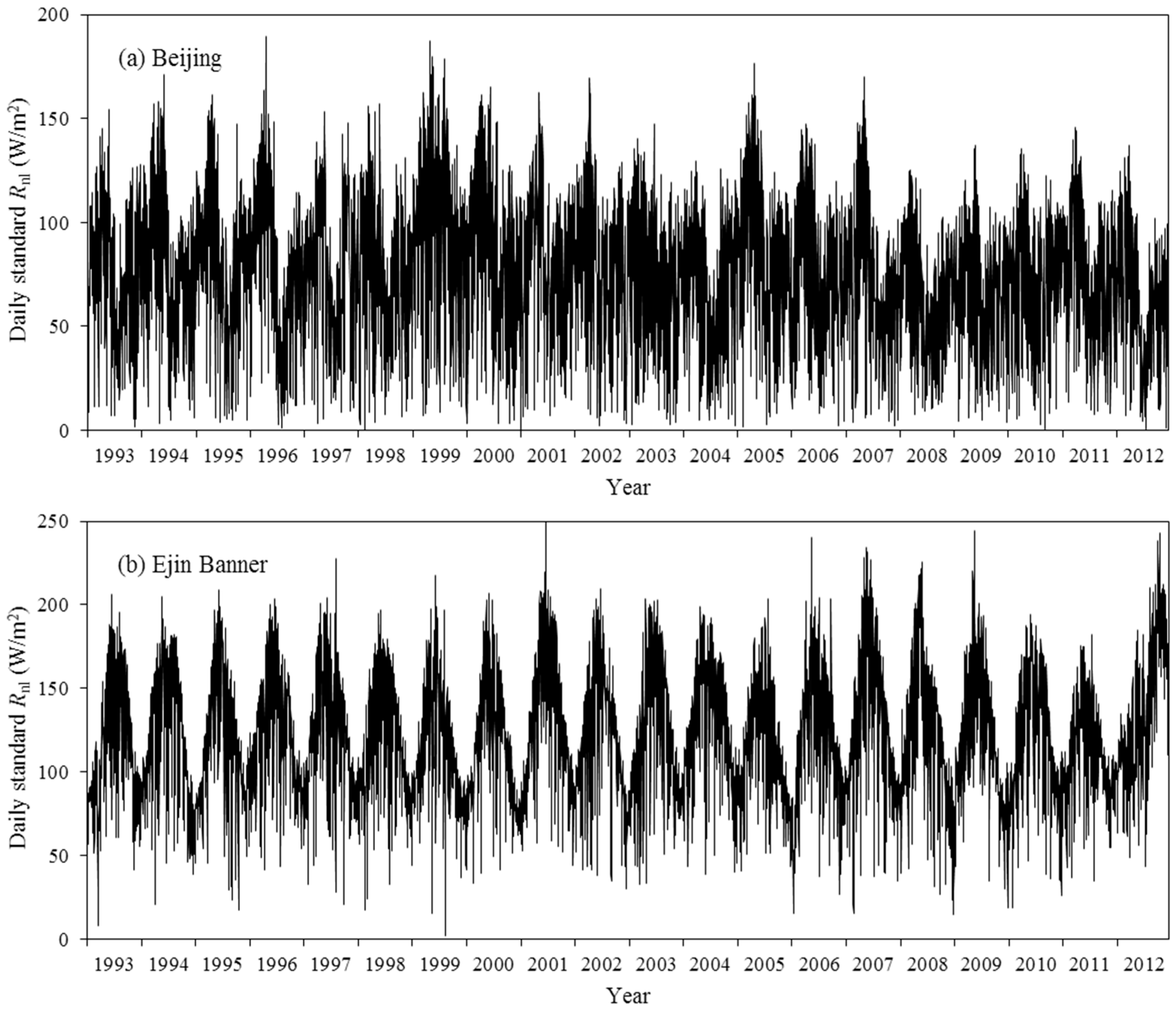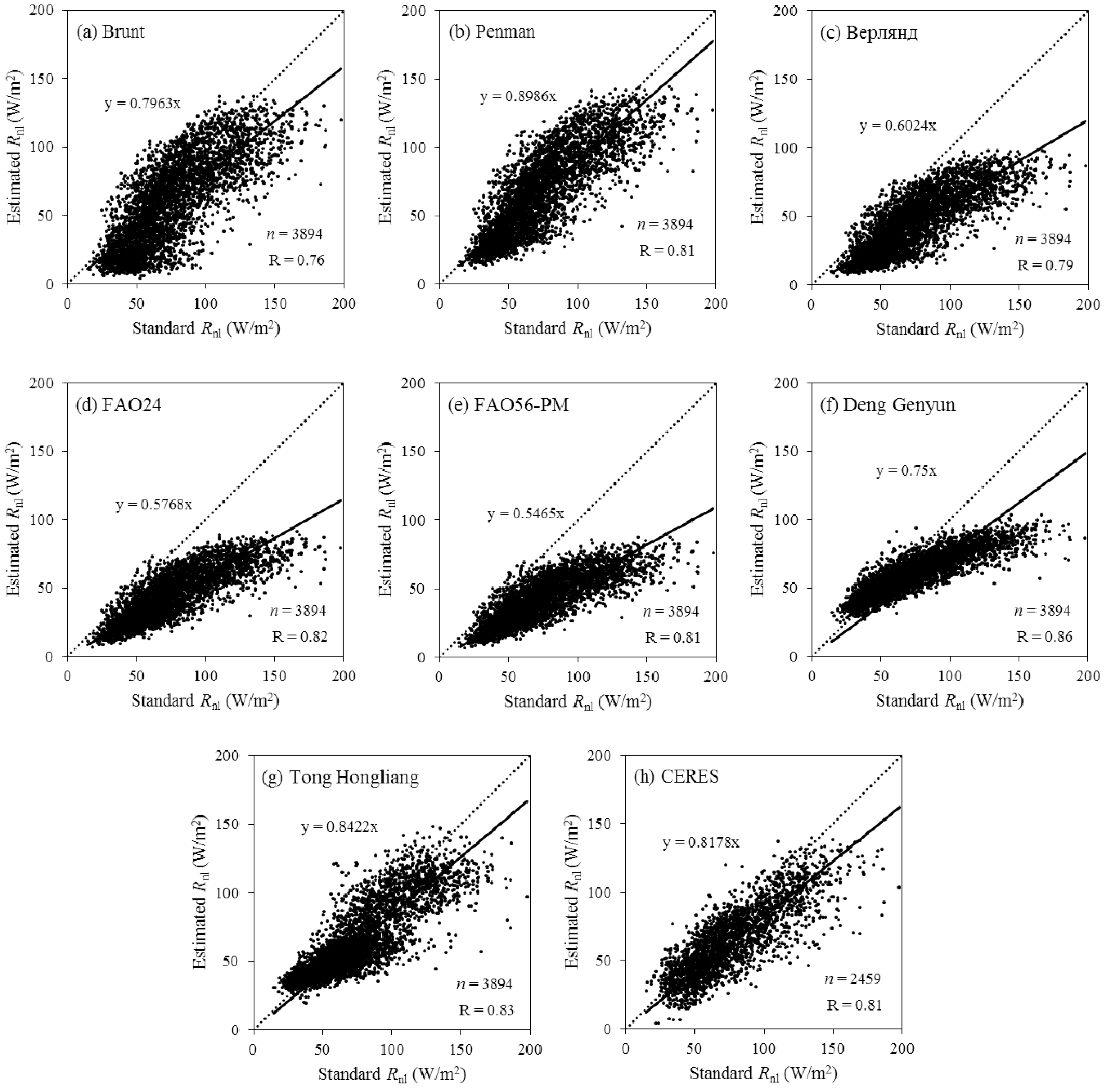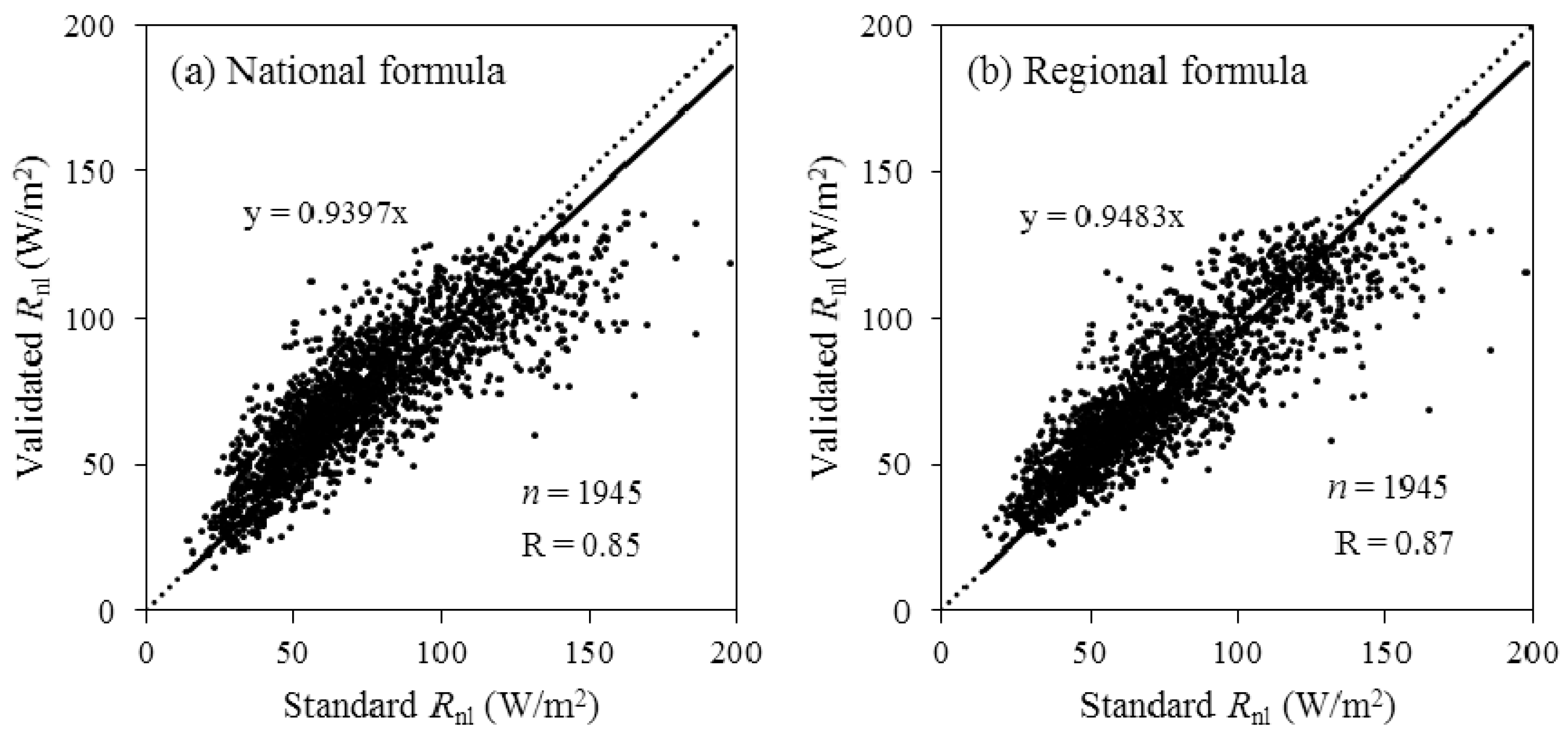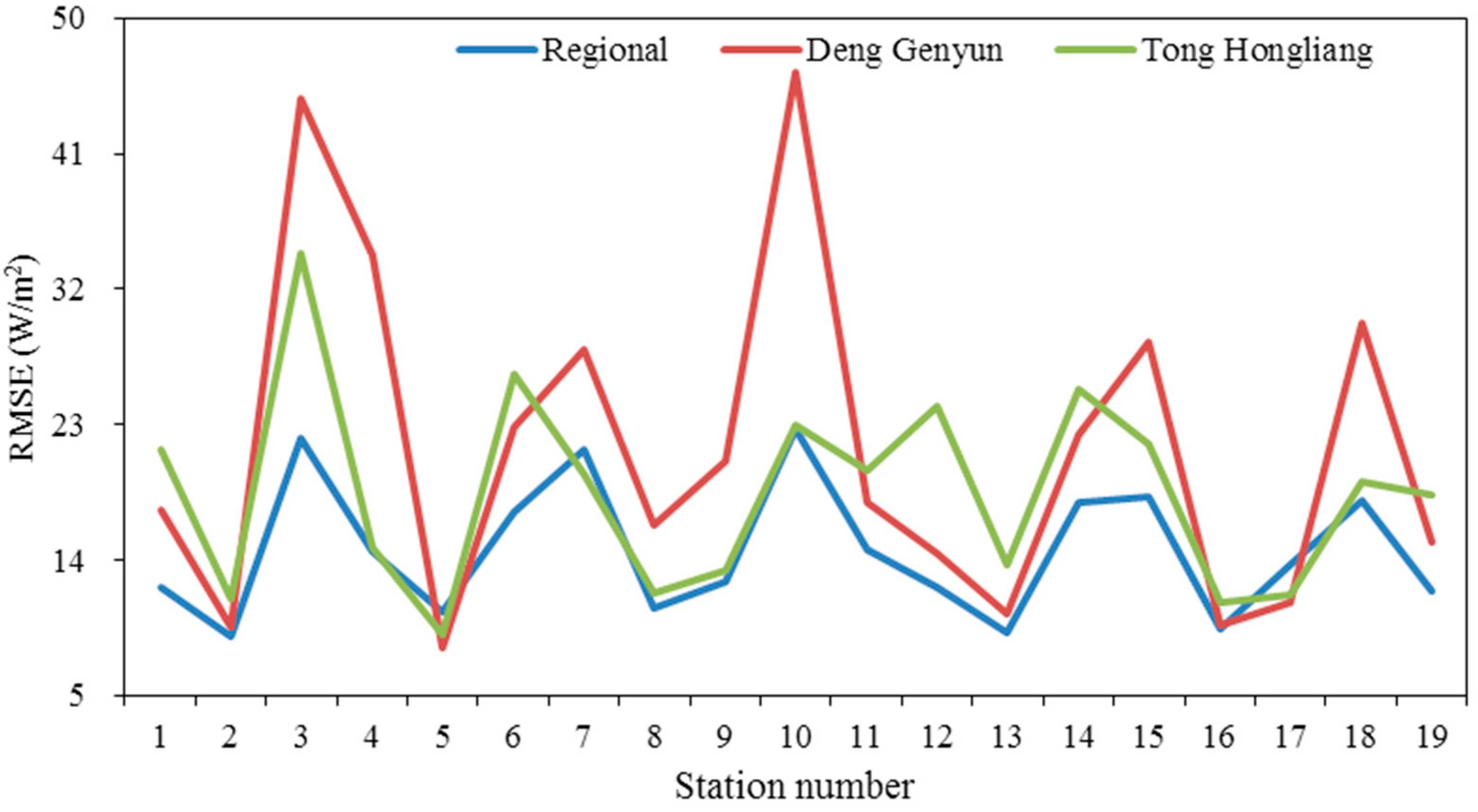3.1. Assessment of the Existing Rnl Empirical Formulas
Based on the observed data during 1993–2012, the monthly
Rnl at the 19 solar radiation stations in China was calculated using the seven formulas listed in
Table 2. The average standard
Rnl of the 19 stations was 75.4 W/m
2. The average estimated
Rnl based on the Penman, Deng Genyun, and Tong Hongliang formulas and CERES data were 69.1, 61.0, 65.4 and 64.6 W/m
2, respectively. They were much closer to the average standard
Rnl than those based on the other four formulas; Brunt, Bepлянд, FAO24, and FAO56-PM formulas produced estimated
Rnl values of 60.3, 46.1, 44.7, and 42.6 W/m
2, respectively. We also compared the R, MBE, MABE, MAPE, and RMSE of the standard and estimated
Rnl based on the seven tested formulas, as well as CERES data for the 19 stations (
Figure 3 and
Table 3). This showed that the
Rnl based on the empirical coefficients recommended in the Deng Genyun formula had the highest R compared with the standard values (
Figure 3f), followed by the Tong Hongliang formula (
Figure 3g). The
Rnl based on the Brunt formula had the lowest R (
Figure 3a). The MBE of the estimated
Rnl was negative for the seven formulas and CERES data, suggesting that
Rnl was underestimated by all of the formulas. In particular, the Bepлянд, FAO24, and FAO56-PM simulations were much lower than the standard values for most of the samples (
Figure 3c–e) compared with those of the other four formulas.
In general, the Tong Hongliang formula had the highest accuracy with the lowest MABE, MAPE, and RMSE among the seven empirical formulas for estimating monthly
Rnl over the whole of China, followed by the Penman and the Deng Genyun formulas. The estimated
Rnl based on the CERES data also showed relatively higher precision in accordance with these three formulas mentioned above. The FAO56-PM formula with the lowest accuracy was not applicable to China. These results agreed with the research of Yin et al. [
47]. For individual stations, the accuracy of the Deng Genyun formula was the highest on the eastern plains. Compared with the other six formulas, the Deng Genyun formula had the lowest MABE, MAPE, and RMSE at nine stations, including Beijing, Chengdu, Harbin, Mohe, Sanya, Shanghai, Shenyang, Wenjiang, and Zhengzhou (
Table 4). The Deng Genyun formula was, therefore, suitable for stations located on the plain in Eastern China at an altitude of less than 600 m. This was most likely because the empirical constants of the relative sunshine duration (
ns/
Ns) were different from those of the other formulas and correctly described the effect of cloud cover on
Rnl. Furthermore, the empirical constants derived from the Beijing station data only using the Deng Genyun formula largely fit east China, suggesting that the coefficient was almost the same for this area. The Tong Hongliang formula was more accurate at stations with an elevation greater than 900 m, including Golmud, Kashgar, Kunming, Lanzhou, Urumuqi, and Yuzhong (
Table 4). The Tong Hongliang formula was suitable for the plateau area because of the altitude correction that is applied when calculating the atmospheric moisture. The FAO24 and FAO56-PM formulas showed the lowest accuracy at most of the stations.
3.2. Establishment of Optimal Rnl Empirical Formulas
The partial correlation analysis showed that the estimated errors of the seven tested formulas were mainly related to water vapor pressure or elevation, except for FAO56-PM. Therefore, water vapor pressure and elevation were the two most critical factors affecting the Rnl estimate. In this paper, apart from revising the formula for the whole of China (hereafter, the national formula), we also established revised regional formulas for the eastern and northwestern areas and the Tibetan Plateau, according to the geographical distribution of water vapor pressure and elevation over China.
First, the monthly standard net long-wave radiation at the 19 stations was calculated based on the surface radiation balance equation using observations from 1993 to 2012. Second, the parameter
b0 in Equation (2) was iterated with a step of 0.01 from 0 to 1. The maximum and minimum air temperature, water vapor pressure, and relative sunshine duration were used as inputs to obtain
a0 and
a1 using multivariate regression for different
b0. Finally, the
Rnl of different
b0,
a0, and
a1 was estimated. The best
b0,
a0, and
a1 was determined using the minimum RMSE between the estimate and standard values as the objective function. Considering the limited data, some samples from odd years (
n = 1949) were used to calibrate the parameters, and the other samples from even years (
n = 1945) were preserved to validate an optimum net long-wave radiation formula calibration, which is called the validated
Rnl. The national and regional formulas are listed in
Table 5.
The correlation coefficient, R, between the validated and standard
Rnl for national and regional formulas, were 0.85 and 0.87, respectively (
Figure 4), which were both higher than those for most of the existing seven formulas evaluated in this study. Some discrepancies existed with
Rnl values greater than 120 W/m
2. However, the two formulas provided a reasonable simulated
Rnl, and the regression equation could adequately describe
Rnl and can be used to analyze
Rnl.
Table 6 presents the MBE, MABE, MAPE, and RMSE of the standard and validated
Rnl based on national and regional formulas for the 19 radiation stations. The negative MBE, with an average absolute value of approximately 1.0 W/m
2 for the 19 stations, illustrates that
Rnl was slightly underestimated by the two revised formulas. Moreover, the validated
Rnl had the lowest average MAPE and RMSE of the 19 stations compared with the other formulas listed in
Table 2. In general, the
Rnl based on the two revised formulas was relatively more accurate compared with the other calculations over China. Therefore, further modifications must be made using meteorological observations when the
Rnl formulas are applied.
As a whole, the average MABE, MAPE, RMSE, and absolute MBE of the 19 stations using the regional formula were smaller than those using the national formula (
Table 6). Furthermore, the
Rnl based on the regional formula showed less MABE, MAPE, and RMSE than that based on the national formula for most stations. The accuracy of the estimated
Rnl, in particular, was significantly improved by the regional formula at the stations located in Eastern China (e.g., Beijing, Chengdu, Guangzhou, Harbin, Kunming, Mohe, Sanya, Shanghai, Shenyang, Wenjiang, Wuhan, and Zhengzhou) and the Tibetan Plateau, while it was slightly improved at the stations located in the northwestern area (e.g., Ejin Banner, Kashgar, Lanzhou, Urumuqi, and Yuzhong) compared with the national formula. The results show that the regional formula was more accurate at estimating
Rnl in China than the national formula, and it is essential to separate the eastern and northwestern areas, as well as the Tibetan Plateau, in the development of the method for the determination of
Rnl.
Figure 5 shows the cumulative frequency of MAPE between the standard and estimated monthly net long-wave radiation values based on the seven existing empirical formulas, two refitted formulas, and CERES data. The frequency of MAPE less than 10.0% was 40% and 35% for the revised regional and national formulas, respectively, followed by Tong Hongliang, Deng Genyun, and Penman formulas, as well as CERES data with the frequency ca. 30%, while the frequency did not exceed 5% for Bepлянд, FAO24, and FAO56-PM formulas. The frequency of MAPE less than 15.0% and 20.0% had similar characteristics. When MAPE was over 40.0%, the frequency exceeded 50% for Bepлянд, FAO24 and FAO56-PM formulas. However, the frequency was less than 10% for the revised regional and national formulas. These results illustrated that the calibrated formulas improved the accuracy of estimating
Rnl over China compared with the original ones, and were more accurate than the estimations based on the CERES data.
Compared with the other five existing formulas, the Deng Genyun and Tong Hongliang formulas were more accurate at estimating
Rnl. Therefore, based on the radiation and observed meteorological data of the 19 radiation stations over China for the full 20 years, we compared the MBE, MABE, MAPE, and RMSE of the standard and estimated
Rnl using the revised regional, the Deng Genyun, and the Tong Hongliang formulas to illustrate the effect of the parameter optimization more clearly. Taking the 19 stations as a whole, the correlation between the estimated and standard
Rnl using the regional formula was higher than that for the Deng Genyun and Tong Hongliang formulas (
Table 7). The MBE of the regional formula was −0.59 W/m
2 and the absolute value was much smaller than that of the other two formulas. The regional formula also produced a lower MABE, MAPE, and RMSE, indicating that it was more accurate than the Deng Genyun and Tong Hongliang formulas.
For most of the 19 stations, the RMSE of the
Rnl based on the regional formula was the smallest among the three formulas (
Figure 6). In particular, the regional formula was clearly more accurate than the Deng Genyun formula at the stations located in Northwestern China (e.g., Ejin Banner, Kashgar, Lanzhou, Urumuqi, and Yuzhong) and the Tibetan Plateau. It was also clearly more accurate than the Tong Hongliang formula at the stations located in the eastern area (e.g., Beijing, Chengdu, Guangzhou, Harbin, Kunming, Mohe, Sanya, Shanghai, Shenyang, Wenjiang, Wuhan, and Zhengzhou). Therefore, we recommend this formula as the standard climatology method to calculate the net long-wave radiation over China.
